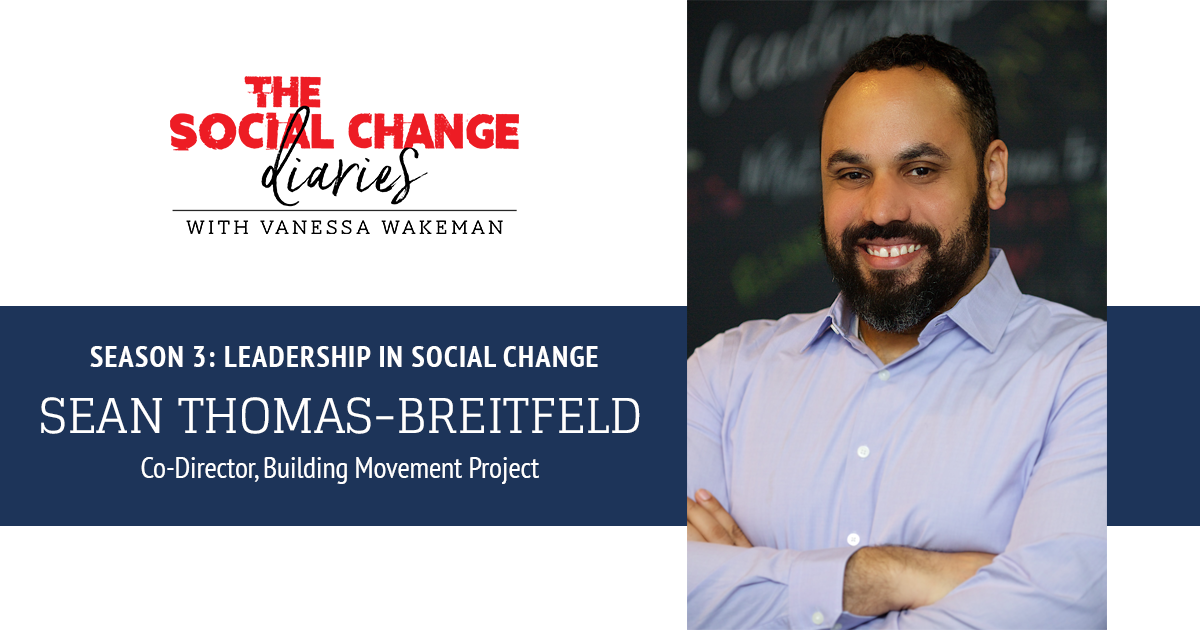

About This Episode
They say what gets measured gets done. A conversation with Sean Thomas-Breitfeld of the Building Movement Project shines a spotlight on the racial leadership gap in the nonprofit sector, as well as some specific measurable actions that can create much needed change in the leadership ranks. In the interview, Sean not only shares the cold, hard facts, he also takes us through his experience of presenting the data and the prevailing opinions of various audiences. This episode is a must listen for anyone that works within the eco-system of social change today.
About
Sean Thomas-Breitfeld co-directs the Building Movement Project, where he develops research, tools, and training materials that bolster the potential of nonprofit organizations to support progressive social change. Prior to joining the BMP staff, Sean spent a decade working in a variety of roles at the Center for Community Change; moving from the policy and communications departments to developing training programs for grassroots leaders. Sean started his career at UnidosUS (formerly NCLR), where he both did research and advocacy on issues related to employment and income security. Sean holds a Master’s Degree in Public Administration from NYU’s Wagner School of Public Service, and a Bachelor’s Degree in Social Work and Multicultural Studies from St. Olaf College in Minnesota.
In his words…
“It was important for people to recognize that we are living with and dealing with a really uneven terrain. For people who are currently senior leaders, who are white, who are in positions of power, I think that it is incumbent on them to recognize those inequities. When they recognize those inequities, take steps to not just recognize it, but take action, and to be really actively supportive of increasing equity and opportunity for people of color inside of their organizations and making structural changes that make it more possible for people to not have to work so hard to move up in their organizations.”
“What does that look like? I think for white CEOs and executive directors, it looks like being very intentional about hiring. It also means being very intentional about board recruitment because if an organization’s board is going to select as the successor to the senior leader, someone who is not like the existing leader– in terms of race or gender or anything else— that person who is going to be exiting eventually has a leadership responsibility to prepare the way for the board to be able to fairly consider someone of color or someone who is in other ways different from the exiting leader.”
“There are a whole set of reasons that foundations often say, ‘well, we have to give smaller grants to organizations that are led by people of color because those organizations send up smaller budgets, and the grant can’t be more than 20% of our organization’s budget.’ All of these sort of rules that foundations have set up. But what that does is leave those organizations smaller, and it also means that the grants are going to continue to be smaller. Unless the foundation decides, ‘we’re going to make some different kinds of decisions in terms of how we support organizations’— I think that organizations led by people of color will continue to, in general, be the smaller and less well resourced enough that we’re struggling to survive than similar organizations led by white leaders.”
“I think a lot of funders recognize the challenges. I think that one thing that I often end up hearing with a funder audience, is ‘we have our own power dynamics to navigate. We have our own boards that we have to convince. We have our own hierarchies that we’re trying to move a strategy for more inclusive, more expansive, more race conscious grant-making.’ A lot of program officers are facing their own challenges. It’s worth recognizing that a lot of program officers were previously nonprofits CEOs. They understand these challenges very well, but they end up navigating their own power dynamic and hierarchy, that I think makes it hard to move progress in the way that I think those of us in the grant seeking side think should be the pace of change.”
Questions Answered on this Episode
- What prompted Building Movement to focus on this particular area of leadership?
- Were there any desired outcomes with the report?
- What was most surprising to you and your team as you analyzed the data?
- The report says, “The prevailing theory of change has been that there needs to be more attention on finding or convincing people of color to consider leadership positions, keeping those who are qualified from leaving the sector, and offering training to the others to prepare them for taking on the top job. Underlying this logic are the assumptions that people of color are less interested in nonprofit leadership than their white counterparts, that qualified leaders of color will leave the nonprofit sector, and that those who stay do not have the skills to be competitive (without help) for top leadership jobs.” Do we know where this theory originated?
- You wrote a blog post titled, Duh, where you talked about the two specific audiences that you would encounter as you presented at conferences to share the findings from Race to Lead. From what you shared, white men and black women had two very different responses to the information shared. Can you talk about that?
- I think the frustration with reports and data of this nature is that we often do a lot of talking about the issues highlighted in the reports but it stops there. I am happy that the report also included calls to action to address the issues highlighted in the report. Who do we hold accountable for taking these actions?
- The report focused on six key findings. There are three that I would to talk through a bit:
– It IS an Uneven Playing Field
– It IS the Frustration of “Representing”
– It’s NOT Personal, It IS the System - Is there one specific action that can have huge impact on improving the numbers within the next 5 years?
- I know that there are additional reports as a follow-up to Race to Lead. What can you share about those?
